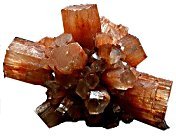

| Types of Rock | | | Properties | | | Volcanoes | | | Articles |
Aragonite

| Chemical Composition: CaCO3 | |
| Group: carbonate |
Hardness: 3.5-4 |
| Colours: colorless, white, gray, yellowish-white, reddish-white | Streak: light green |
Density: 2.9 |
Luster: vitreous |
Cleavage: distinct in one direction1 |
Acid sensitive: yes |
Aragonite is a calcium carbonate CaCO3 . Aragonite and calcite are the most common naturally occurring polymorphs of calcium carbonate. Both minerals have the same chemical structure but differ in their crystal structure.
Whereas calcite is characterised by a trigonal crystal system, Aragonite creates orthorhombic crystals (for more information about the crystal structure see The crystal systems of minerals on this site). The name of this mineral comes from Aragon, the region of Spain where it was first discovered.
A characteristic feature of Aragonite is twinning. Twinning is a process which occurs during crystal growth when the crystal is subjected to stress or temperature/pressure conditions different from those under which it originally formed. In this way two or more intergrown crystals are formed in a pseudo-hexagonal symmetrical fashion. These symmetrical intergrowths of crystals are called twinned crystals.
Aragon is famous for its abundance of beautiful speciments of twin Aragonite with this characteristic type of symmetry. Aragonite crystals are usually colourless or white if seen individually, but as aggregates they often exhibit different colours. Most Aragonites are nearly pure calcium carbonate, though small amounts of strontium Sr and less commonly barium Ba and lead Pb may be present as impurities.
Aragonite is not stable at the relatively low temperatures and pressures found near the Earth's surface, as a result there is a continuous process of inversion into calcite. This a a slow process which happens on a scale of 107 to 108 years (i.e. millions or tens of millions of years). This process can be sped up by temperature increase without changes of pressure, so at normal pressure but temperatures of about 400oc Aragonite spontaneously reverts to calcite.
This partly explains why calcite is much more abundant that Aragonite. Aragonite occurs as the hard skeletal material of certain fresh-water and marine invertebrate organisms, including pelecypods (eg. Clams, oysters, mussels), gastropods (creatures such as snails, slugs, and whelks), and some corals.
The accumulated debris from these skeletal remains can be thick and extensive, usually on shallow sea floors, and with time may transform into limestone. Interestingly most limestones contain calcite and little or no Aragonite and this transformation of Aragonite to calcite is an important step in forming limestone. The formation of limestone is proceeded by the dissolution of Aragonite followed by the precipitation of calcite in the presence of water.
Other occurrences of Aragonite include cave deposits (often in unusual shapes) and weathering products of calcium-rich rocks.
Aragonite commonly associate with many minerals including: gypsum, barite, smithsonite, malachite, calcite, serpentine, sulfur, celestite, zeolites, quartz, clays, dolomite, limonite, chalcopyrite. It is also quite widely distributed; being found in Aragon, Spain; Morocco; Bastennes, France; Girgenti, Sicily; Alston Moor and Cleator Moor, Cumberland, England; Baja California, Mexico (Mexican Onyx); Tsumeb, Namibia; Carinthia, Austria; Leadhills, Scotland; the Harz Mountains, and Germany. and in several locations in the Southwestern United States including California.
It is also found in several locations in the Southwestern United States including California. Interestingly, the young age of the California blueschists has been famously demonstrated by the finding therein of Aragonite which has not yet reverted to calcite.
 |
| Rocks in Focus |
© Biscuit Software 2016